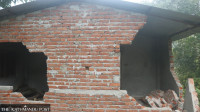National
Repair work at flood-hit Melamchi project likely to take months
With the road to the project site cut off after floods last month, officials aren’t sure when the repair work will begin. The project to supply drinking water to Kathmandu Valley has suffered losses worth over Rs1 billion, as per initial estimates.
Chandan Kumar Mandal
The Melamchi Water Supply Project, which was significantly damaged due to floods nearly two weeks ago, is headed into uncertainty as officials are not sure when the repair work will start.
In the second week of June, heavy rains triggered landslides and floods in different parts of Sindhupalchok district. The devastation was mostly suffered by Melamchi Bazar and the nearby areas, including the Melamchi project site.
The project’s headworks site at Ambathan remains buried in flood debris several metres deep.
According to Rajendra Prasad Pant, spokesperson for the Melamchi Water Supply Development Board, it remains uncertain when the debris clearance and restoration works will begin.
“If we go by the normal process, then work might start by September/October. Even at the earliest, visiting the site and starting damage assessment and repairs does not look possible for two-three months or until the end of the monsoon season,” Pant told the Post. “We can start clearing the debris from the headworks site only after the floodwaters recede and clear water starts flowing in the river.”
As per the initial assessment, the project has suffered more than Rs1 billion worth of damage.
Pant, who is also a senior divisional engineer with the board, said 10 to 15 metres of debris has piled up at the project site and the cleanup work could cost Rs300-Rs350 million. Likewise, the floods have damaged the roads and bridges to the project site and washed away the campsite and construction materials.
“We need to rebuild the camp site, restore electricity and construct canteens for the workers,” said Pant. “Most importantly, road connectivity to the flooded site remains disrupted. Improving roads and installing bridges is likely to take more time even before the cleanup work could be started.”
The board has requested the Department of Roads and Nepal Army to repair the road and instal Bailey bridges to restore connectivity.
“Nepal Army has Bailey bridges for restoring connectivity during disasters. If they can provide some bridges and ferry them by helicopter, it will help us reach the headworks site at Ambathan,” said Pant. “We can start clearing the debris from the headworks area."
Although the main tunnel, which ferries water from the Melamchi river in Sindhupalchok district to the Kathmandu Valley, remains intact, the process of inspecting the tunnels by flushing out water from the main tunnel is also affected due to the floods.
Hours before the floods, the project had closed the gates to the main tunnel and started emptying the water from the Sundarijal site to inspect the tunnel and complete the remaining work at the headworks site.
Over a two-month tunnel inspection period, the water from the tunnel would be released first from the Sundarijal site and then from Gyalthum and Ambathan. After Sundarijal, water had been released from Gyalthum, but it is not possible to do so from Ambathan as the site remains blocked by flood debris.
There is also another problem. Government officials suspect that the floodwaters and debris could have entered the alternative diversion tunnel of the headworks.
The diversion tunnel was built for draining the area for the construction of the headworks. Later, it was also used as an alternative tunnel for taking water into the main tunnel and flushing it. A 60-metre long pipe with 1600mm diameter has been attached at the top of the tunnel.
“The diversion tunnel was used for supplying river water to the main tunnel whenever the headworks had to be closed for inspection. The diversion tunnel would ensure that water supply to the main tunnel remains unhindered,” said Pant. “Since the pipe has been installed at the upper section of the diversion tunnel, there is a small chance of the flood debris entering the pipe. But if sand and stones have entered the pipe, then it needs to be cleared manually, which will take more time.”




 10.12°C Kathmandu
10.12°C Kathmandu















